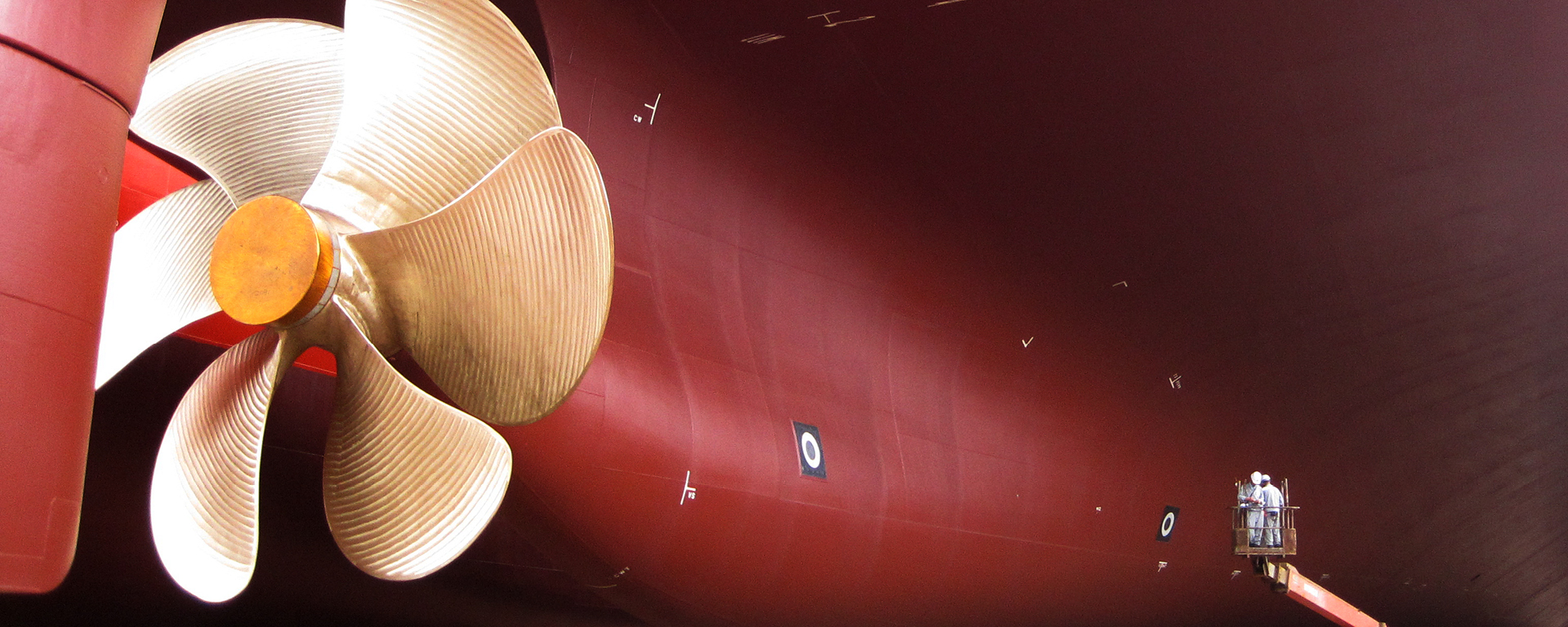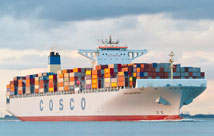Environmental
As a leader in the maritime industry, Seaspan recognizes that a sustainable business model must be founded on strong and consistent policies and principles to protect the global environment. Through technological advances and customer and industry partnerships, we are doing our part in controlling emissions, managing waste, and preserving local biodiversity. While present programs are outlined in our Sustainability Report, the pursuit of new initiatives to further improve environmental performance continues.

Shipping represents one of the most efficient and cost-effective modes of transportation, and accounts for more than 80% of global trade by volume. Seaspan recognizes the importance of developing and promoting sustainable shipping practices, and leveraging its fully integrated operating platform and expertise to address the environmental impacts of its business. Seaspan aims to contribute to environmentally sustainable and climate-resilient development in the industry, a commitment that goes beyond meeting environmental laws and regulations.
CLIMATE CHANGE AND EMISSIONS
Seaspan’s emissions performance is influenced by vessel design, travel speed, trade route, cargo carried and continuous efficiency updates and vessel modifications developed through its asset development program.
Based on the Fourth International Maritime Organization (“IMO”) Report, shipping contributes approximately 3% of global anthropogenic carbon dioxide emissions. In 2018, the IMO announced targets to reduce the total annual GHG emissions from the shipping sector by at least 50% by 2050, and achieve zero GHG emissions as soon as possible, in this century. The IMO also set a target to reduce vessel carbon intensity by 40% by 2030, and by 70% by 2050. To meet and exceed the IMO’s GHG reduction targets, Seaspan has developed a decarbonization strategy based on four pillars:
Continuous Efficiency Improvement
Seaspan Action for Vessel Energy Reduction or “SAVER”, is Seaspan’s eco-vessel initiative aimed at improving the overall efficiency of the vessel, reducing fuel consumption and improving cargo loadability
Transition Pathways
Seaspan’s CleanBlue initiative, researches the viability of low and zero carbon fuels and energy convertors, such as battery, wind, heat recovery, etc.
Build institutional knowledge vault to add value to discussions with customers and other strategic partners
Fleet Insight
Development of data systems and analytical capability, providing actionable insights and intelligence to be used for decision support and improved operational performance
Market Based Initiatives
Focus on commercial and financial aspects, including revenue generation and value preservation of our assets. These initiatives involve collaboration with customers and industry partners to develop practical solutions and offerings that enhance our value proposition
Seaspan commissioned ten 15,000 TEU and fifteen 7,800 TEU dual-fuel LNG container newbuilds. These ultra-modern and efficient containerships are anticipated to begin deliveries in the first half of 2023, and upon completion will enter service on long term time charters with a global container liner. Currently, LNG is the most commercially viable cleaner burning fuel source, and an important step in the transition to low-carbon fuels as they become commercially available for deep sea container shipping. The use of Bio-LNG and e-Methane provide a path for these vessels to easily meet the IMO 2050 targets
ECOSYSTEMS AND BIODIVERSITY
According to the World Economic Forum, more than half of global GDP is reportedly dependent on a functioning biodiversity and ecosystem. A decline in biodiversity due to collapsing ecosystems would threaten economies around the world. It is estimated that a fifth of countries globally (20%) are at risk. The World Economic Forum’s 2020 Global Risk Report ranks biodiversity loss and ecosystem collapse as one of the top five risks in terms of likelihood and impact in the coming 10 years.
Seaspan is taking action to limit the impact of its business on marine ecosystems and biodiversity, as outlined below.
Ballast Water Management
Ballast water is of key environmental concern due to the likelihood of transporting aquatic species (including micro-organisms) into non-native waters, which can then act as invasive species and harm the local marine ecosystem.
Seaspan’s newbuild vessel program includes a Ballast Water Management System compliant with both IMO and U.S. Ballast Water discharge standards. To date, approximately 85% of Seaspan’s fleet is fitted with a Ballast Water Management System compliant with IMO standards.
Thanks to in-house training for seafarers, an internal compliance and verification program, and early adoption of ballast water treatment technology, Seaspan crew and management are well prepared and trained in the treatment of ballast water onboard its ships.
Oil Pollution
Oil spills are one of the most recognizable environmental incidents that can impact the physical and chemical alteration of natural habitats and have a significant effect on flora and fauna.
Given the detrimental effect on the environment, the maritime industry has continuously evolved and strengthened regulations relating to design, operation, effluent limits, liability and crew training in areas concerning marine pollution.
In 2021, there were no incidents involving significant oil spills from our ships (significant non-contained oil spills = 5m3).
Plastic Waste Management
There is no doubt that plastic waste in our oceans is harmful to marine life as well as the broader ecosystem and human health. The economic impact of marine pollution also has a direct effect on tourism, fisheries and shipping.
In response to this growing concern, Seaspan has taken the following steps to reduce plastic waste:
Reduce the dependency on packaged drinking water in plastic bottles by supplying water filtration units on board. Personal, stainless steel water bottles are available for crew members. Potable water testing is part of planned maintenance to ensure safe drinking water
New vendors are vetted for their policy on plastic packaging materials and discouraged from bringing them on board ships. Crew members are encouraged to return plastic packaging materials to suppliers for recycling
A ban on single use plastics imposed by various states, extending to vessels calling on ports in those jurisdictions, has further discouraged the use of such materials on board vessels. These actions and increased awareness have resulted in a gradual behavior shift among Seaspan seafarers, resulting in a reduction in the quantity of plastic waste disposed from our ships, monitored on a year-over-year basis
Container Loss Overboard
Container loss overboard a ship presents a unique marine pollution hazard. The nature and extent of marine pollution from lost containers at sea varies according to their contents. In addition to the threat of contamination posed by the contents of a container, the body and coatings of the container also poses an environmental hazard.
To address this issue, Seaspan brings together several programs and systems. Examples include: application of best management practices and procedures, regular crew training, up-to-date lashing software, onboard maintenance regime and third-party inspections.
Ship Recycling
Ship recycling enables the reuse of a significant portion of a ship’s structure by weight, through careful dismantling. The ship recycling industry actively supports many developing countries’ economies and is an important contributor to sustainability efforts, due to its role in recycling metals and other components. However, ship recycling must be performed according to strict standards that protect human health, safety, and the environment. Every year, hundreds of ships are dismantled in poor environmental and social conditions by workers receiving low pay, often with inadequate tools and little protection. Without rigorous processes and strong governance, the process can also cause significant pollution, offsetting the environmental benefits of ship recycling.
The IMO’s Hong Kong International Convention for the Safe and Environmentally Sound Recycling of Ships, introduced in 2009 (the Hong Kong Convention), aims to protect workers and the environment during the ship recycling process.
Seaspan has developed its Ship Recycling Policy and all Seaspan vessels maintain certification required by the Hong Kong Convention. Furthermore, the company’s purchase process ensures that hazardous materials, noted in the governing legislation, are properly identified, declared and an accurate inventory of hazardous materials is maintained.
Seaspan is committed to safe, sustainable, socially responsible recycling of ships and strives to ensure that recycling of any of its ships performed at shipyards does not present any unnecessary risk to human health and safety, and the environment. Seaspan joined the Ship Recycling Transparency Initiative as a member in 2022.
|
|
To learn more about Seaspan’s sustainable shipping practices, please explore our Sustainability Report found here as a PDF. |






